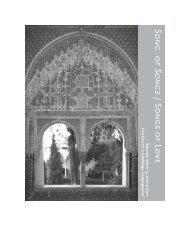BH1001, Guillaume Du Fay: Motets - Blue Heron
BH1001, Guillaume Du Fay: Motets - Blue Heron
BH1001, Guillaume Du Fay: Motets - Blue Heron
Create successful ePaper yourself
Turn your PDF publications into a flip-book with our unique Google optimized e-Paper software.
Brown never claimed that instrumental participation<br />
was the rule, nor did Fallows or Page categorically<br />
rule out the possibility. Page, for his part,<br />
admits that “No contemporary theorist describes<br />
this technique [wordless vocalization], as far as I<br />
am aware, and no contemporary name for it is<br />
known; no rubric or canon in any medieval musical<br />
source can be confidently interpreted as a call<br />
for it.” 12 It now seems that the most responsible<br />
conclusion that may be drawn from our current<br />
knowledge of the evidence is that fifteenth-century<br />
song was probably performed in a variety of<br />
ways: by voices only, with untexted parts either<br />
vocalized or texted, partially or fully; by a mixed<br />
ensemble including one or more instruments, of<br />
which the most common were harp, lute, portative<br />
organ, fiddle, recorder, or other or bas (“soft”)<br />
instruments such as douçaine; or by an entirely<br />
instrumental ensemble.<br />
Again, we have chosen from a variety of solutions<br />
for the chansons recorded here. In Entre vous,<br />
gentils amoureux and Puisque vous estez campieur,<br />
the texted, canonic discantus and tenor parts are<br />
sung, while the untexted contratenor is played<br />
on a fiddle. The contratenor of Puisque vous,<br />
leaping and dashing about between the canonic<br />
voices, seems particularly well suited to the fiddle.<br />
In Malheureulx cueur we have underlaid text<br />
to the tenor; 13 the contratenor is again played<br />
on fiddle. The fiddle (or vielle) used is a fivestring<br />
instrument by Karl Dennis whose model<br />
is derived from various medieval representations.<br />
It is strung entirely in gut, and the tuning is cd-g-d’-g’,<br />
a tuning of my own devising which is<br />
related to that of c-d-g-c’ given in the fourteenthcentury<br />
Berkeley Theory manuscript. As Page<br />
notes, “This is an unlikely tuning for a flat-bridged<br />
bowed instrument, but it might well be used on<br />
a round-bridged one”; 14 that is, one that could<br />
play a single line of a polyphonic work.<br />
Je me complains, J’atendray tant, Mon cuer me fait<br />
tous dis penser, and Mon doulx espoir have text in<br />
all the voices in their unique source, a Venetian<br />
manuscript from c. 1425–1436 (Oxford 213), and<br />
are performed by voices alone. In Par droit je<br />
puis bien complaindre et gemir, the two untexted<br />
contratenors are vocalized. In Permanent vierge,<br />
we have added the French text to the two<br />
untexted contratenor parts; the two tenors<br />
sing the Latin texts of the antiphons, which are<br />
underlaid in the source.<br />
To conclude, a brief word about flats and sharps.<br />
As anyone familiar with fifteenth-century music<br />
knows, the original sources do not tell us explicitly<br />
everything we would like to know about<br />
exactly what pitches the composer intended;<br />
the question most often encountered, besides<br />
when to raise or lower a note at a cadence, is<br />
the choice between B (B mi, b durus) and B<br />
(B fa, b mollis), especially in F-mode pieces. Our<br />
ears have favored B rather more often than one<br />
tends to hear nowadays, and the results are<br />
quite striking in Mon cuer me fait tous dis penser,<br />
11



